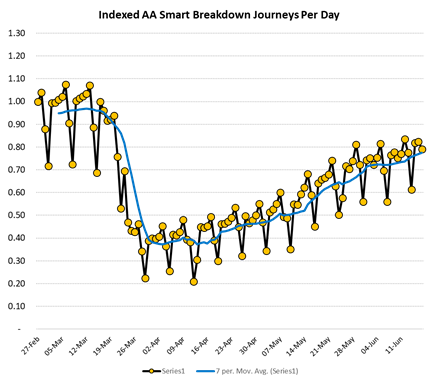Coronavirus: Traffic levels 'now double the lockdown low'
- Published
Before and after: Aerial shots show how lockdown changed the use of roads and public spaces
Traffic on Britain's roads is now at a similar level to that seen in the late 1980s and early 1990s, the AA says.
It slumped to between 35% and 40% of the pre-coronavirus volume at the beginning of lockdown but has since doubled to around 75%.
AA head of roads policy Jack Cousens told the BBC that traffic could return to normal "by the end of July".
But Friends of the Earth said pollution should not be allowed to "creep" back to the pre-pandemic level.
Traffic has gradually increased since early April, as travel restrictions have eased and hundreds of thousands of people have returned to work.
The government is discouraging people from using public transport if it is avoidable, and has told passengers to wear masks, in an effort to limit the spread of coronavirus.

The AA monitors traffic levels on a daily basis - the rolling seven-day average level is denoted by the blue line
Mr Cousens said: "The message to avoid public transport is certainly resonating as, week by week, more people have ventured out in their cars."
He added that "due to the disappearance of the night-time economy" there was still "very little traffic" after 19:00, while weekends were quieter than usual because of the cancellation of mass events.
"As shops re-open, while hairdressers and other up-close occupations prepare to return in early July, traffic could reach pre-lockdown levels by the end of July," Mr Cousens said.
UK carbon emissions reportedly fell by 31% in April,, external but have increased since.
Mike Childs, head of science at Friends of the Earth, said: "Any decline in emissions during enforced lockdown will be for nought if levels ramp back up.
"By saying that people should get behind the wheel now, the government themselves are contributing to increased pollution from road use."
The UK government has pledged £250m for improvements in cycling and walking infrastructure and many towns and cities are making more road space available for pedestrians and those on bikes.

FACE MASKS: When should you wear one?
YOUR QUESTIONS: Our experts have answers
LOOK-UP TOOL: How many cases in your area?